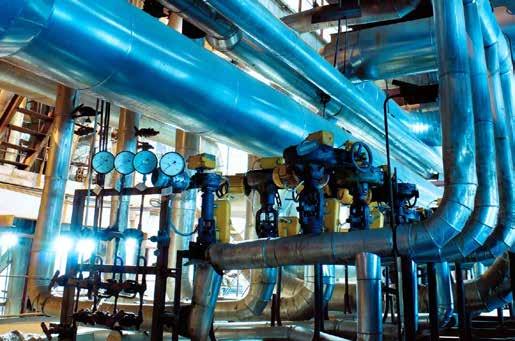
4 minute read
Biorefining - back to the future?
from SPN April 2023
by spnews.com
Could going back to the future by using the complex polymers found in wood, be the sustainable way forward for plastic packaging production? In a world where 96% of products – including plastic packaging, rely on chemical intermediates for their manufacture , the chemical industry urgently needs to find alternatives to fossil-based feedstocks to help tackle the climate crisis.
“In contrast to oil or natural gas, the use of renewable carbon from wood to produce bio-based products will have an important role - alongside carbon from direct CO2 utilisation and carbon from recycling of existing materials - in delivering a net zero future, argues Martin Ledwon, Vice President Sustainability, UPM Biorefining”.
Advertisement
Ledwon told SPN: “The risks of climate change now need little introduction. The ambition to limit global warming to 1.5°C is now hanging by a thread, with voices challenging whether keeping within the 1.5°C trajectory is even still feasiblenow making each 0.1°C rise above 1.5°C hugely significant”.
Narrowing window
With an increasingly narrow window to stabilise climate, it is now incumbent upon major primary industries to take a broader approach to sustainability than solely through decarbonising of energy sources. In addition to championing a truly circular economy, due to its immense responsibility to supply intermediate products to downstream manufacturers, the chemicals industry needs to curb its high dependency on fossil fuel completely. Specifically, this means finding alternative, renewable feedstocks to replace current petroleumbased ones in the production of chemical intermediates.
Often referred to as “renewable carbon”, the alternative feedstock sources available today are from biomass (typically wood, crops, manure, algae, etc.), from carbon capture or from the recycling of materials already used. For the purposes of this discussion, we are focusing on wood.

Root of the problem
In the 1950s the world produced only 2 million metric tons of plastic products annually. The amount has now risen to more than 400 million metric tons of which around 141 million is diverted to the manufacture of packaging.
According to the Organisation for Economic Co-operation and Development, plastics production was responsible for 1.8 billion metric tons of greenhouse gas emissions in 2019, equating to 3.4% of total global GHG emissions – higher than the aviation sector which comes under significantly more scrutiny.
Slow response
The chemical industry generates over $3.5 trillion in revenues annually, representing around 4% of global GDP – roughly equal to the output of Russia, the world’s fourth largest emitting country - and directly employing over 11 million people. But it also accounts for 4% of global greenhouse gas emissions, of which the International Energy Agency (IEA) estimates 75% is from the production of large-volume chemical intermediates (e.g. ethylene, propylene, benzene, toluene, ammonia, and methanol).

If the current pace of growth and manner of production continues, plastic packaging’s share of emissions is set to significantly increase. The World Economic Forum estimates that the plastic industry currently accounts for as much as 6% of global oil consumption and expected to reach 20% by mid-century.
But we need to look back through the plastic production value chain, to find the real root of the problem. Producing the many varieties of plastic requires a wide range of chemical additives – and while each has its own special formula, they all come from a base of fossil fuels.
Specifically, the chemical industry is responsible for the vast number of fossil-based materials to manufacture plastic goods which form a significant part of our modern consumer world – including feedstocks for polyethylene terephthalate (PET), a form of plastic that can be moulded into bottles and packaging for countless food and personal care products. In fact, many would argue that the industry has been slow in its ambition to develop innovative, less CO2-intensive feedstocks for plastic packaging materials.
But with almost the entire carbon feedstock used in the chemical system currently from virgin fossil sources, the transition to alternative feedstocks represents an enormous challenge. However, one biochemical innovator that has risen to the challenge - Finnish company, UPM Biochemicals – will be the first to produce wood-based biochemicals on a large scale.
Look to the forest
Trees are composed of 20-30% of lignin, a complex polymer found in the wood cell walls and giving wood its stiffness and resistance to degradation. This valuable compound can serve as raw materials in the production of bio-based chemicals which can be used in the manufacture of man-made fibres, among many other products. Lignin also offers UV and temperature stability, and even enhances moisture resistance, so helping to prevent bacterial and fungal attack. It is these properties that make lignin an ideal bio-based substitute for various petroleum-based products used today.

At our new state-of-the-art €750 million biorefinery in Leuna, Germany, which is due to become operational in 2024, we will primarily use beechwood feedstock, from which we will produce 220,000 tonnes of biochemical intermediates annually.
All our beechwood, including branches and off-cuts, are sustainably sourced from certified (FSC/PEFC), locally managed local forests, so neither competes for land for food production, nor requires fertilisers – two of the biggest criticisms of some other bio-feedstocks such as sugarcane. UPM also oversees the responsible planting, growing, harvesting and collection of beech trees, plus the residues and so-called thinnings from sawmill operations – of which around 70% normally ends up being incinerated.
New, drop-in Glycols
It’s from this fully sustainable source that we have developed a new generation of renewable bio-based “drop-in” glycols. Mono-ethylene glycols (MEG) which are used extensively in PET resins are vital ingredients in the production of countless types of packaging.
Integration into existing manufacture can be easily implemented because our bio-glycol, BioPura™, is a molecular like-for-like substitute, enabling a much more sustainably sourced, virgin PET to be manufactured. Ideally, this innovative bio-based PET will be mechanically recycled at the end of life, just as its fossil-based counterparts should be. If it cannot, there is an option for it to be chemically recycled using ‘glycolysis’, with the process requiring additional new bio-based MEG to create new recycled PET. Through integrating BioPura™ as the additional “ingredient” will create a holistic circular economy in the PET value chain.
Back to the future
Wood is one of humanity’s most ancient raw materials but it can also take us into the future. UPM Biochemicals is at the vanguard of the transition to a circular bioeconomy – where sustainable, renewable production and consumption is the new normal. It is pioneering sustainable chemistry – innovating in chemical processes, scaling biorefining and unlocking the potential of biomass to transform industries.
Replacing fossil and mineral-based materials with wood-based biochemical ingredients will also lock-in carbon sequestered from the atmosphere for the life of the product. This enables us to radically reduce the carbon footprint of materials and provide better, more sustainable choices to consumers”.











